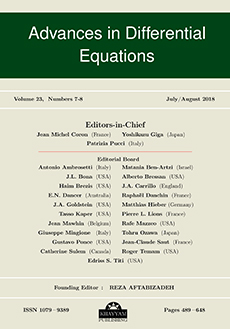Abstract
We describe the local pointwise structure of multiple zeros of solutions of $2m$th-order linear uniformly parabolic equations, \begin{equation} \tag*{(0.1)} u_t = \sum _{|{\beta} | \le 2m} \, a_{\beta}(x,t) D^{\beta}_x u \quad {\rm in} \,\,\, {{\bf R}^N} \times [-1,1] \quad (m \ge 2), \end{equation} with bounded and Lipschitz-continuous (for $|{\beta}|=2m$) coefficients, in the existence-uniqueness class $\{|u(x,t)| \le B {\mathrm e}^{b|x|^{\alpha}}\}$, where $B,b>0$ are constants and ${\alpha} = \frac {2m}{2m-1}$. Assuming that $u(0,0)=0$ and using the Sturmian backward continuation blow-up variable $ y=x/(-t)^{\frac 1{2m}} \quad (t < 0), $ we perform a classification of all possible types of formation as $t \to 0^-$ of multiple spatial zeros of the solutions $u(x,t)$. We show that there exists a countable family of multiple zeros evolving as $t \to 0^-$ according to the nodal sets of polynomial eigenfunctions of a non-self-adjoint operator ${{\mathbf B}}^*$ associated with that in (0.1). Next, we show that other related polynomial solutions occur in the collapse of multiple zeros as $t \to 0^+$, which is described in terms of the forward continuation variable $ y=x/t^{\frac 1{2m}} \quad (t>0). $ For the 1D second-order ($m=1$) parabolic equation with smooth coefficients, $$ u_t= a(x,t) u_{xx} + q(x,t) u \quad (a(x,t) \ge a_0>0), $$ this two-step analysis is known as {Sturm's Second Theorem} on zero sets, established by C.~Sturm in 1836, [32]. His more famous First Theorem (the number of zeros of solutions is non-increasing with time ) was derived as a consequence of the second one. In the last thirty years these PDE ideas of Sturm found new applications, generalizations and extensions in various areas of general parabolic theory, stability and orbital connection problems, unique continuation and Poincaré--Bendixson theorems, mean curvature and curve shortening flows, symplectic geometry, etc. Using such a local classification of multiple zeros, we establish a unique continuation theorem for higher-order parabolic PDEs and inequalities, and estimate the Hausdorff dimension of nodal sets of solutions. It turns out that some common features of multiple zeros formation can be observed for solutions of other PDEs including linear dispersion and wave equations, $$ u_t=u_{xxx} \quad \mbox{and} \quad u_{tt}=u_{xx}, $$ and we present a discussion on this issue.
Citation
V. A. Galaktionov. "Sturmian nodal set analysis for higher-order parabolic equations and applications." Adv. Differential Equations 12 (6) 669 - 720, 2007. https://doi.org/10.57262/ade/1355867449
Information





